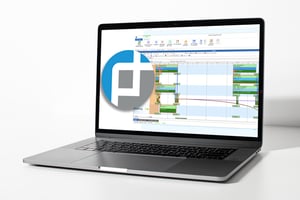Topics: PlanetTogether Software, Reduced Lead Times, Integrating PlanetTogether, Improve Efficiency, Enhanced Flexibility, Workforce Management, Optimized Resource Utilization, Better Data-Driven Decision Making, Packaging Manufacturing
For Operations Directors in packaging manufacturing facilities, optimizing workforce management is a constant challenge. With the advent of advanced scheduling systems like PlanetTogether and the integration possibilities with ERP, SCM, and MES systems such as SAP, Oracle, Microsoft, Kinaxis, and Aveva, there's a unique opportunity to streamline operations and drive productivity to new heights.
In this blog, we'll look into the benefits and strategies of integrating workforce management with scheduling systems, exploring how this synergy can revolutionize packaging manufacturing operations.

Packaging manufacturing is inherently complex, involving a myriad of processes and variables that need to align seamlessly to meet production targets. One of the critical aspects of this intricate puzzle is workforce management. Coordinating labor resources efficiently, ensuring optimal staffing levels, and aligning workforce schedules with production demands are essential for operational success. However, traditional approaches to workforce management often fall short in meeting these demands, leading to inefficiencies, downtime, and increased costs.

This is where advanced scheduling systems like PlanetTogether come into play. These sophisticated software solutions leverage advanced algorithms and real-time data to optimize production scheduling. By considering factors such as machine capacity, material availability, and order priorities, these systems generate optimized production schedules that maximize throughput while minimizing downtime and resource wastage. However, to unlock their full potential, these scheduling systems need to be integrated seamlessly with workforce management processes.
Integration between scheduling systems and workforce management brings a host of benefits to packaging manufacturing facilities:
Improved Efficiency: By aligning workforce schedules with production schedules, integration ensures that the right number of workers are available at the right time, minimizing idle time and maximizing productivity.
Enhanced Flexibility: With real-time visibility into production schedules, managers can adjust workforce allocation on the fly to accommodate changing demand patterns or unexpected disruptions, ensuring continuous operations without compromising efficiency.
Optimized Resource Utilization: Integration allows for better utilization of labor resources, reducing overtime costs and minimizing the need for temporary staffing by accurately forecasting staffing requirements based on production schedules.
Reduced Lead Times: By streamlining production processes and eliminating bottlenecks, integration helps in reducing lead times, enabling packaging manufacturers to meet customer demands more promptly and maintain a competitive edge in the market.
Data-Driven Decision Making: Integration facilitates the seamless exchange of data between scheduling systems and workforce management platforms, providing actionable insights that empower decision-makers to make informed choices and drive continuous improvement initiatives.

Integrating workforce management with scheduling systems requires careful planning and execution. Here are some key strategies to ensure successful implementation:
Define Clear Objectives: Clearly define the goals and objectives of the integration project, whether it's reducing labor costs, improving productivity, or enhancing customer service. Having a clear roadmap will guide the integration process and help measure its success.
Select the Right Technology Partners: Choose software vendors that offer robust integration capabilities and have experience in integrating scheduling systems with ERP, SCM, and MES platforms. Ensure compatibility between the systems and establish seamless communication channels for data exchange.
Standardize Data Formats: Standardize data formats and protocols to facilitate smooth data exchange between scheduling systems and workforce management platforms. Establish data mapping processes to ensure that information flows seamlessly between different systems without any loss or distortion.
Implement Real-Time Integration: Aim for real-time integration between scheduling systems and workforce management platforms to enable timely decision-making and response to changing production conditions. Implement APIs or middleware solutions to facilitate continuous data synchronization and updates.
Provide Training and Support: Train employees on how to use the integrated systems effectively and provide ongoing support to address any issues or challenges that may arise. Encourage collaboration between different departments to ensure alignment and synergy across the organization.
Integrating workforce management with scheduling systems offers a myriad of benefits for packaging manufacturing facilities, ranging from improved efficiency and flexibility to optimized resource utilization and reduced lead times. By leveraging advanced technologies and strategic partnerships, Operations Directors can transform their operations and stay ahead of the competition in today's dynamic market landscape.
Integrating workforce management with advanced scheduling systems like PlanetTogether offers a comprehensive solution that enhances operational efficiency in packaging manufacturing. It leverages technology to maximize productivity, reduce costs, and maintain high standards of quality and compliance. For companies looking to remain competitive in the fast-paced manufacturing sector, such integration is not just beneficial but necessary.
Embracing integration is not just a choice but a necessity for packaging manufacturers looking to thrive in the digital age. Are you ready to take your manufacturing operations to the next level? Contact us today to learn more about how PlanetTogether can help you achieve your goals and drive success in your industry.
Topics: PlanetTogether Software, Reduced Lead Times, Integrating PlanetTogether, Improve Efficiency, Enhanced Flexibility, Workforce Management, Optimized Resource Utilization, Better Data-Driven Decision Making, Packaging Manufacturing
0 Comments
No video selected
Select a video type in the sidebar.







LEAVE A COMMENT